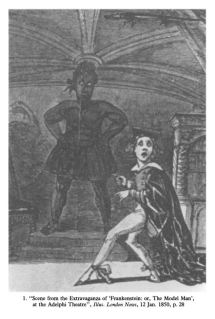 Title: Frankenstein; or, The Model Man
Title: Frankenstein; or, The Model Man
Author: Richard and Barnabas Brough
Date of First Publication: 1849
Place of Publication: London
Type: play
Characters: Victor Frankenstein; The Creature
Themes: BYRONIC HERO; MAD SCIENTIST/MONSTER; SYMPATHETIC MONSTER
Critical Summary: The play introduces characters from Frankenstein’s college. Zamiel gives Frankenstein an elixir to make his creation come to life. The viewer also meets the couple Otto and Agatha. The spirit of the Flood, Undine, appears before Otto and Agatha, proposing to help them at a dire moment.
Frankenstein creates his monster, and is too terrified to give it an opportunity to interact with him. The monster is inexplicably well-spoken. It expresses vengefulness toward Frankenstein for being created, then rudely dismissed. The monster follows Frankenstein into a Ball, and begins to cause destruction and death. Frankenstein reveals the cause of the turmoil as being his experiment. Otto encounters Undine again, who promises to help calm the monster. She says that rather than harm the monster, they should educate it. She hands him a flute that will be used for this purpose.
Frankenstein is taken prisoner and brought to trial for murder. The Baron argues that the actions of the monster are the responsibility of Frankenstein, and he should be charged accordingly. Otto steps in asking for the Baron’s blessing to marry Agatha, if he is able to stop the monster. The Baron agrees and Otto reveals he has already stopped it. He explains his method, and the monster steps in dressed neatly and speaking eloquently. Frankenstein accepts the monster in his arms with pride. Undine tells the Baron that Zamiel is the one who should pay for all the crimes.
Just like in Mary Shelley’s novel Frankenstein, the monster is capable of reasoning. Though, in contrast, the monster in the play can speak immediately, while the monster in the novel learns this ability. This difference with the play may have been caused by time constraints. In any case, both monsters show high intelligence, not something that occurs frequently in play adaptations.
The theme of the Sympathetic monster is explored in this play, since the monster displays human qualities immediately after he opens his eyes. By the end of the play, he becomes educated, making him acceptable to the rest of the humans in the play. Meanwhile, due to the monster’s first reactions, the play also contains the theme of the mad scientist. The Creature kills, but, unlike Shelley’s novel, no one of direct consequence to Frankenstein dies in the play. This is done to make it possible for Frankenstein’s creature to be accepted and redeemed, since the harm done was not given as much attention. All this allows a humorous tone and a light ending to occur where everything is well.
Mary Shelley is briefly mentioned in the play, as a way to credit her for her work as an origin for this particular play.
Administrative Notes: Francia Somera, CSUF; Dr. David Sandner, CSUF (editing)
